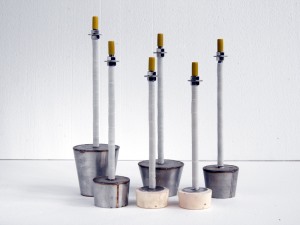Several raw materials of breathable bricks
The raw materials of breathable bricks are mainly sintered magnesia, magnesia-chromium, high alumina and corundum.
1, sintered magnesia breathable brick
Sintered magnesia material refers to the refractory material with a MgO content of more than 80%. It belongs to the basic refractory material. It has the advantages of high refractoriness, strong corrosion resistance to alkaline slag, no corrosion by Ca, CaO, and no pollution of molten steel. Its large thermal expansion coefficient and poor thermal shock resistance make the material easy to fall off, which greatly reduces the service life of magnesia refractory materials.
2, magnesia chrome breathable brick
Magnesium-chromium material is a refractory material with MgO, Cr2O3 as the main components, and periclase and pinite as the main mineral components. Because of its inertness to steel-making slag and compatibility with other refractory materials, chrome ore is The appearance of magnesia-chromium materials has improved the deficiencies of the thermal shock resistance of magnesia materials.
3, high-alumina breathable brick
High-alumina materials refer to refractory materials with Al2O3 content greater than 48 percent. They have the characteristics of high cold and hot strength, good wear resistance, thermal shock resistance, anti-shedding and good volume stability at high temperatures. However, they are resistant to slag corrosion and penetration. The function is not good enough to resist the moisture and penetration of the slag on the bricks in the whole contract.
4, corundum breathable brick
Corundum material refers to the refractory material with Al2O3 content greater than 90%. Corundum is made of industrial alumina or bauxite after sintering or electrofusion. When industrial alumina is electrofused, white corundum is obtained. The content of Al2O3 is greater than 98.5%; when bauxite is used as raw material, general corundum is obtained; when iron filings are added, brown corundum is formed; when germanium stone or germanium oxide is added, germanium corundum is obtained, and Cr2O3 is added to obtain chromium Corundum, fused tabular corundum is a tabular corundum formed in a semi-molten state in an electric arc furnace at 1900-2000 degrees Celsius directly with industrial alumina as the main raw material. It is conducive to the volatilization of volatile impurities such as Na2O, so it is also the process of purification and purification. The characteristics of plate-shaped alumina materials are high thermal conductivity, good thermal stability, high temperature strength, strong corrosion resistance, and high production costs.
Under high temperature and vacuum, it is a better choice to use corundum as the main crystal phase of the breathable brick. At the same time, the melting point of Cr2O3 is 2275 degrees Celsius, which is higher than the melting point of Al2O3 (2050 degrees Celsius), and alumina and chromium oxide can form a continuous solid solution. The corrosion resistance of the solid solution composed of AI2O3-Cr2O3 to iron oxide or slag is significantly enhanced. The addition of a small amount of Cr2O3 can inhibit the excessive growth of alumina crystals, thereby reducing the internal stress of the crystals and improving the physical properties of the material. If too much Cr2O3 is added, the growth rate of corundum grains will be seriously affected, and then the physical properties of the material will be reduced. Therefore, the introduction of an appropriate amount of Cr2O3 can improve the thermal shock stability, erosion resistance and corrosion resistance of the material, but from the perspective of environmental protection, The introduction of Cr2O3 will cause pollution to the environment, so the introduction of Cr2O3 should be carefully considered.
To realize the bottom-blowing argon process of ladle permeable bricks, ladle permeable bricks must have excellent high temperature resistance, corrosion resistance, thermal shock resistance, high temperature volume stability and high strength, good air permeability, stable operation, accurate external dimensions, and molten steel penetration. Fewer features.

Related News
- Introduction of construction method of ramming material in intermediate frequency furnace
- How to choose the material of furnace lining
- The difference between rammer and castable
- Application direction of intermediate frequency furnace refining
- Introduction to the construction method of dry ramming material
- Do you know the production process and control points of breathable bricks?
- The application of argon blowing technology at the bottom of the intermediate frequency furnace
- Method for prolonging service life of intermediate frequency furnace lining
- In addition to diffused breathable bricks, there are those types of breathable bricks
- What are the advantages of coil cement
- How to repair the lining of the intermediate frequency furnace?
- What points should be considered when choosing intermediate frequency furnace charge? Luoyang Sinosteel Refractories
- The performance of each product of ladle bottom blown argon breathable brick, impermeable type breathable brick, and split breathable brick
- What is the difference between rammer and castable?
- What is the difference between refractory plastic and ramming material?
- 5 benefits of using dry ramming mixes
- Wear-resistant ramming material during the knotting process
- Furnace lining baking process sharing
- 4 main reasons for the damage of ladle breathable bricks
- Analysis of Characteristics of Refined Ladle Dispersion Type Breathable Bricks


